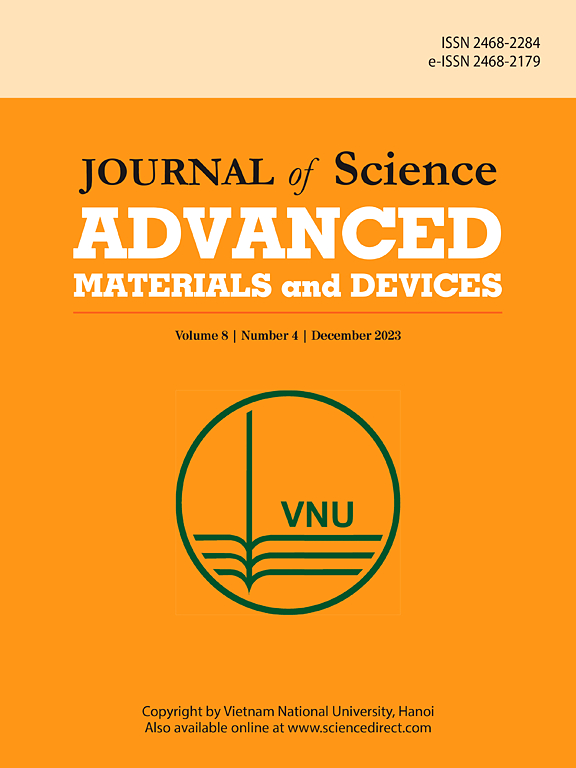Partially exfoliated graphite oxide and lignin composites for battery electrode materials
IF 6.7
3区 材料科学
Q1 MATERIALS SCIENCE, MULTIDISCIPLINARY
Journal of Science: Advanced Materials and Devices
Pub Date : 2025-04-05
DOI:10.1016/j.jsamd.2025.100887
引用次数: 0
Abstract
Lignin has garnered significant research attention as a sustainable alternative for various materials and applications. However, its effectiveness as an exfoliating agent and its electrochemical properties have yet to be fully explored and validated. To address this gap, our current study focuses on the synthesis of hybrid materials based on a partial exfoliation of graphite and its oxidized analog, employing a novel method in which the ultrasound (US) forces applied are enhanced by the incorporation of lignin, further promoting the exfoliation. During the synthesis process, graphite layers are separated, and lignin particles are intercalated between these layers, promoting exfoliation. In this study, we incorporated two types of lignin, namely Kraft lignin (KL) and organosolv lignin (OL), and characterized the resulting materials using physicochemical (FTIR, Raman, EA, XRD, and XPS), morphological (AFM, and SEM), and electrochemical (CV and EIS) techniques. The physicochemical and morphological analyses provided substantial evidence supporting the exfoliating capacity of lignins and their deposition on the partially exfoliated surface. Interestingly, the effectiveness of lignins was found to be more pronounced in the case of oxidized graphite (GO) as compared to non-oxidized graphite. This observation was further corroborated by improved electrochemical performances, evidencing the deposition of lignin particles and the exfoliation as positive contributions to enhanced capacity values.
部分剥落氧化石墨和木质素复合材料的电池电极材料
木质素作为各种材料和应用的可持续替代品,已经引起了人们的广泛关注。然而,其作为去角质剂的有效性及其电化学性能尚未得到充分的探索和验证。为了解决这一差距,我们目前的研究重点是基于石墨及其氧化类似物的部分剥落合成杂化材料,采用一种新的方法,通过木质素的掺入增强超声波(US)力,进一步促进剥落。在合成过程中,石墨层被分离,木质素颗粒嵌入这些层之间,促进剥离。在这项研究中,我们加入了两种类型的木质素,即卡夫木质素(KL)和有机溶质木质素(OL),并使用物理化学(FTIR,拉曼,EA, XRD和XPS),形态(AFM, SEM)和电化学(CV和EIS)技术对所得材料进行了表征。理化和形态学分析为木质素的剥落能力及其在部分剥落表面的沉积提供了有力的证据。有趣的是,与非氧化石墨相比,木质素的有效性在氧化石墨(GO)的情况下更为明显。电化学性能的改善进一步证实了这一观察结果,证明木质素颗粒的沉积和剥落是提高容量值的积极贡献。
本文章由计算机程序翻译,如有差异,请以英文原文为准。
求助全文
约1分钟内获得全文
求助全文
来源期刊

Journal of Science: Advanced Materials and Devices
Materials Science-Electronic, Optical and Magnetic Materials
CiteScore
11.90
自引率
2.50%
发文量
88
审稿时长
47 days
期刊介绍:
In 1985, the Journal of Science was founded as a platform for publishing national and international research papers across various disciplines, including natural sciences, technology, social sciences, and humanities. Over the years, the journal has experienced remarkable growth in terms of quality, size, and scope. Today, it encompasses a diverse range of publications dedicated to academic research.
Considering the rapid expansion of materials science, we are pleased to introduce the Journal of Science: Advanced Materials and Devices. This new addition to our journal series offers researchers an exciting opportunity to publish their work on all aspects of materials science and technology within the esteemed Journal of Science.
With this development, we aim to revolutionize the way research in materials science is expressed and organized, further strengthening our commitment to promoting outstanding research across various scientific and technological fields.
 求助内容:
求助内容: 应助结果提醒方式:
应助结果提醒方式:


